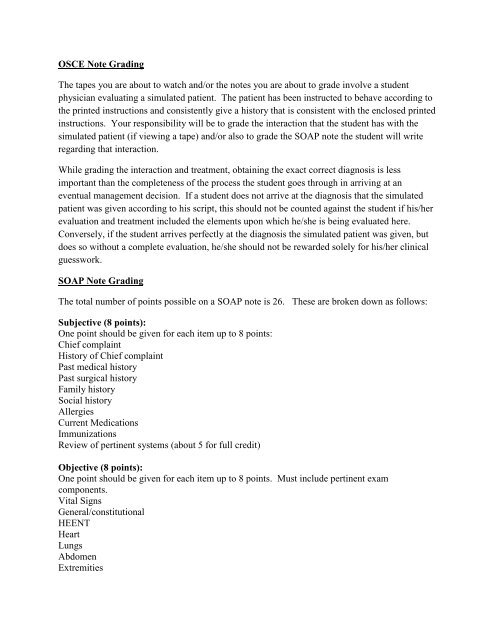SOAP Note Grading Guide
SOAP Note Grading Guide
SOAP Note Grading Guide
Create successful ePaper yourself
Turn your PDF publications into a flip-book with our unique Google optimized e-Paper software.
OSCE <strong>Note</strong> <strong>Grading</strong><br />
The tapes you are about to watch and/or the notes you are about to grade involve a student<br />
physician evaluating a simulated patient. The patient has been instructed to behave according to<br />
the printed instructions and consistently give a history that is consistent with the enclosed printed<br />
instructions. Your responsibility will be to grade the interaction that the student has with the<br />
simulated patient (if viewing a tape) and/or also to grade the <strong>SOAP</strong> note the student will write<br />
regarding that interaction.<br />
While grading the interaction and treatment, obtaining the exact correct diagnosis is less<br />
important than the completeness of the process the student goes through in arriving at an<br />
eventual management decision. If a student does not arrive at the diagnosis that the simulated<br />
patient was given according to his script, this should not be counted against the student if his/her<br />
evaluation and treatment included the elements upon which he/she is being evaluated here.<br />
Conversely, if the student arrives perfectly at the diagnosis the simulated patient was given, but<br />
does so without a complete evaluation, he/she should not be rewarded solely for his/her clinical<br />
guesswork.<br />
<strong>SOAP</strong> <strong>Note</strong> <strong>Grading</strong><br />
The total number of points possible on a <strong>SOAP</strong> note is 26. These are broken down as follows:<br />
Subjective (8 points):<br />
One point should be given for each item up to 8 points:<br />
Chief complaint<br />
History of Chief complaint<br />
Past medical history<br />
Past surgical history<br />
Family history<br />
Social history<br />
Allergies<br />
Current Medications<br />
Immunizations<br />
Review of pertinent systems (about 5 for full credit)<br />
Objective (8 points):<br />
One point should be given for each item up to 8 points. Must include pertinent exam<br />
components.<br />
Vital Signs<br />
General/constitutional<br />
HEENT<br />
Heart<br />
Lungs<br />
Abdomen<br />
Extremities
Neurological<br />
GYN/GU<br />
Skin<br />
Musculoskeletal<br />
Structural: A specific somatic dysfunction, listed by nomenclature or description of<br />
TART/STAR findings is an objective finding-no different than describing heart or lung<br />
sounds<br />
Assessment (3 points):<br />
Three rational assessments justified by the elements of the <strong>SOAP</strong> note above are required. These<br />
may take the form of DIFFERENTIAL diagnoses or medical problems pertinent to the case."<br />
(For OMM Case, at least 1 diagnosis should clearly state “Somatic Dysfunction” and related<br />
region or regions)<br />
Medical diagnoses or symptoms are listed before the diagnosis of somatic dysfunction (which<br />
usually relates to the medical diagnosis). Somatic dysfunctions are listed by region (body area)<br />
not the name of the specific finding.<br />
There are 10 standard somatic dysfunction areas: Head, Cervical, Thoracic, Lumbar, Sacrum,<br />
Pelvis, Ribs, Upper Extremity, Lower Extremity, Abdomen/Other<br />
Plan (3 points):<br />
Three elements of plan are required. These may include, but are not limited to, patient<br />
education, further testing, medication, physical therapy, osteopathic manipulative treatment,<br />
follow up, home care and first aid, or home exercise.<br />
List OMM performed as part of plan. List treatment type used, the region treated, and patient<br />
response to treatment<br />
Legibility (2 points):<br />
The notes clearly readable (2 points)<br />
The notes readable with some difficulty (1 point)<br />
The notes illegible (0 points)<br />
Organization (2 points):<br />
The notes organized with subjective, objective, assessment, and plan elements correctly<br />
identified (2 points)<br />
The notes largely correct in their organization with no more than 2 errors in elemental division (1<br />
point)<br />
There are more than 2 errors in elemental division (0 points)<br />
<strong>Note</strong>: Naming Somatic Dysfunctions<br />
Use segmental definition (regional or local) to name the dysfunction.<br />
Remember, somatic dysfunctions are named in position of ease.
Although this name is referred to as the diagnosis, in a written soap note it is actually an<br />
objective finding: it is the identifying descriptor for a structural finding

















